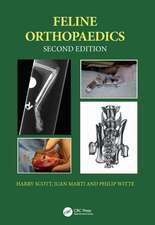Concise Textbook of Small Animal Handling: A Practical Handbook
Autor C. B. Chastainen Limba Engleză Paperback – 15 mar 2022
- Handler safety
- Animal safety
- Sanitation
- Approach and capture
- Routine handling and release procedures
- Handling for medical procedures
- Use and supply sources of restraint equipment
| Toate formatele și edițiile | Preț | Express |
|---|---|---|
| Paperback (1) | 245.81 lei 3-5 săpt. | +21.78 lei 4-10 zile |
| CRC Press – 15 mar 2022 | 245.81 lei 3-5 săpt. | +21.78 lei 4-10 zile |
| Hardback (1) | 672.25 lei 6-8 săpt. | |
| CRC Press – 25 apr 2022 | 672.25 lei 6-8 săpt. |
Preț: 245.81 lei
Preț vechi: 258.74 lei
-5% Nou
47.04€ • 48.93$ • 38.84£
Carte disponibilă
Livrare economică 24 martie-07 aprilie
Livrare express 07-13 martie pentru 31.77 lei
Specificații
ISBN-10: 0367628139
Pagini: 242
Ilustrații: 51 Tables, black and white; 96 Line drawings, color; 96 Illustrations, color
Dimensiuni: 156 x 234 x 22 mm
Greutate: 0.46 kg
Ediția:1
Editura: CRC Press
Colecția CRC Press
Public țintă
Further/Vocational Education and Undergraduate CoreNotă biografică
Recenzii
I think this handbook would serve any veterinary professional or clinic well. I also think it is a great substitute for the larger animal restraint texts available as the conciseness highlights the material readers are often looking for.
Stephen Cital RVT, SRA, RLAT, CVPP, VTS-LAM, Stanford University, USA
Safe animal handling is a foundation of training for veterinarians, veterinary technicians, and veterinary assistants. With the popularity of various low stress training and certifications for veterinary staff it is always important to stay abreast of the latest in animal restraint. This handbook is an easy to use and practical guide for various species. I particularly found the exotic companion mammal, bird, and reptile sections of great interest. The artwork in the handbook adds to the text's descriptions so readers are not left self-interpreting how the technique should be performed. I appreciate the author's attention to not only human safety but also the welfare of the animals undergoing restraint.
I think this handbook would serve any veterinary professional or clinic well. I also think it is a great substitute for the larger animal restraint texts available as the conciseness highlights the material readers are often looking for.
Stephen Cital RVT, SRA, RLAT, CVPP, VTS-LAM, Stanford University, USA
This is an excellent textbook - I would even go to say an essential textbook for anyone interested or going into the animal care industry or interested in studying any animal management/welfare course. I have recommended this text to our librarian and undergraduates on the BSc degree course. The book is suitably designed outlining the handling and restraint methods that can be used along with suitable illustrations / photographs of the techniques. Pros and cons as well as considerations for animal and human welfare / safety are nicely described.
Catheryn Hancock BVetMed MSc DWEL certAVP PGcertEd PGcertVA MRCVS
Cuprins
Descriere
This instructional pocket reference condenses the most important aspects of small animal handling. It provides a portable, durable means of learning 'on the ground', as well as a convenient way to refresh on how to strive for safety and efficacy in animal handling techniques. Spiralbound for practical use at the animal's side during veterinary placements in a clinic or laboratory, the text covers:
- Handler safety
- Animal safety
- Sanitation
- Approach and capture
- Routine handling and release procedures
- Handling for medical procedures
- Use and supply sources of restraint equipment
A Companion Website provides additional self-assessment questions and answers to aid learning. Important reading for undergraduate veterinary students as well as practicing technicians, nurses and assistants, the book instructs on safe and humane handling of species encountered in both small animal practice and laboratory settings.




